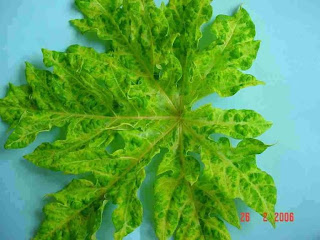
A group of farmers engaged in Papaya cultivation in Moradabad region have found a desi way of tackling the Papaya Mosaic disease. They spray a dilute solution of groundnut Oil on the crop as soon as the symptoms of the disease appear. The disease doesn't surface after that, they say. The efficacy of the 'treatment technique' has even impressed the state agriculture department, which is promoting it as a "natural cure" for the dreaded disease. Caused by Papaya Mosaic Potexvirus (PapMV), the disease has been a major deterrent in the cultivation of the crop across India. While the farmers say that they took a cue from ancient Ayurvedic books to find a way to beat the disease, scientists, too, say that groundnut oil has the potential to help fight viruses that cause the mosaic disease.
"The fatty acids in groundnut oil not only kill PapMV virus but also curb aphids that transmit the disease, thereby checking further spread of disease," said Dr Shiv Singh, an agriculture scientist, based in Moradabad. "In fact, these fatty acids can also aid in the growth of the Papaya plant," added Dr Singh. Elaborating on the nature of the disease, Dr Singh said though mosaic virus is known to attack the papaya plants of all age groups, it affects younger plants more gravely. Leaf distortion, malformation of fruits, reduction in fruit size and blisters on the surface of fruit are a common occurrence "Symptoms appear on the young leaves of the plants. The leaves are reduced in size and show blister like patches of dark-green tissue, alternating with yellowish-green lamina. The leaf petiole is reduced in length and the top leaves assume an upright position. "The infected plants show a marked reduction in growth. The fruits borne on disease plants develop water soaked lesions with a central solid spot. Such fruits are elongated, reduced in size and not fit for consumption," he said. Explaining the procedure being adopted by farmers to cure the crop, Dr Singh said that the solution is prepared by mixing one litre of groundnut oil in around 100 litres of water. "The solution not only prevents the virus from spreading but also ensures better growth of the plant and also the fruit," Dr Singh claimed. In Uttar Pradesh, districts like Ghaziabad, Rampur, Moradabad, Bulandshaher and Saharanpur are major producers of this short-lived herbaceous plant called Carica papaya.
courtesy: pic - british society for plant pathology : article - indian express
 here is something i can vouch for. though normally i use tobacco with garlic. this time i am going to try this combination and check the results.
here is something i can vouch for. though normally i use tobacco with garlic. this time i am going to try this combination and check the results.
